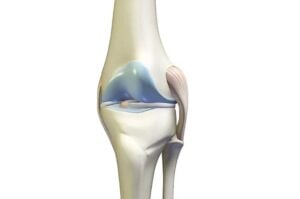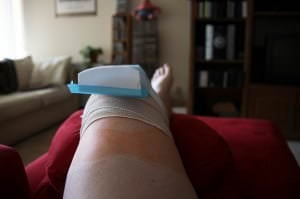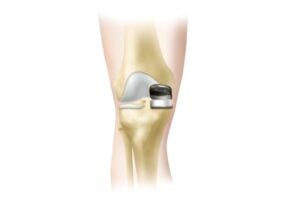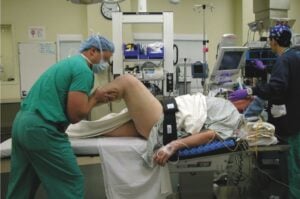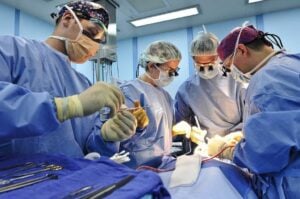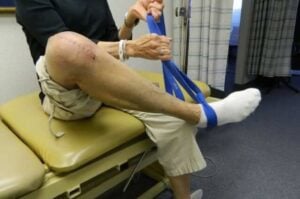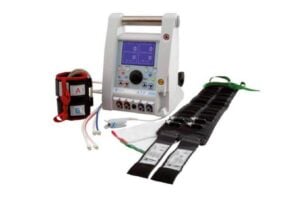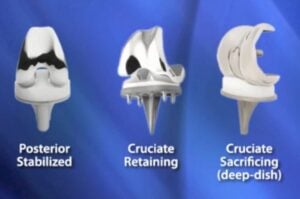Knee replacement surgery involves replacing some or all of the components of the knee joint with a synthetic implant, to repair the damaged weight-bearing surfaces that are causing pain. A total knee replacement surgery replaces all three compartments of the diseased knee joint. A partial knee replacement involves an implant in just one or two compartments of the knee, retaining any undamaged parts. While there are non-surgical and surgical interventions short of knee replacement which will often provide temporary relief, the long-term resolution to most knee degeneration will be joint replacement.
There are several different implant designs (see: total implants | partial implants) but each will offer renewed stability and movement. Overall, there are two main benefits to be gained from knee replacement surgery: (1) elimination of pain and (2) improved range of motion. Of all possible surgical interventions, total knee replacement offers the greatest quality of life improvement. The procedure has a high rate of success.
In order to make an informed decision about knee replacement surgery, it may be beneficial to learn more about the various implant options and the surgery itself.
In order to understand knee replacement it helps to first understand the knee joint itself, the types of knee replacement ...
To fully understand your knee degeneration, the knee replacement procedure and the mechanics of your knee implant, you will first ...
The ultimate goal of minimally invasive surgery is not only to make a shorter skin cut, but also to reduce ...
Online patient communities and patient forums, like our own knee replacement forum, have proven to be useful sources of much needed support ...
Bilateral knee replacement surgery means that both knees are replaced at the same time. It's relatively uncommon to have the ...
One of the most important things you will want to discuss with your chosen knee surgeon is the type of ...
You've suffered through pain and discomfort related to your knee degeneration and have finally decided to consult with an orthopedic ...
In computer-assisted robotic surgery, a robot acts as an extension of the surgeon’s eyes and hands in a minimally invasive ...
Knee replacement surgery - like all surgeries - is generally only recommended after all conservative (non-invasive) treatment options fail to ...
In the 1960s and 1970s, most believed that total knee implants would last about 10 years. This was one of ...
Pain is a major concern for patients who are about to have total knee surgery. Post-operative knee replacement patients want ...
The most common diagnosis of the cause of knee pain prior to knee replacement is osteoarthritis. If you are prevented ...
Most patients undergoing total knee replacement surgery want to know when they'll be able to return to their normal life ...
Many patients are eager to know when they can return to work and resume their normal activities after knee replacement ...
Knee replacement has become the most common form of joint replacement surgery. In 2010 over 721,000 such procedures were performed in ...
Every total knee replacement implant and many total hip replacement implants utilize ultra-high molecular-weight polyethylene (UHMWPE), a plastic, in their ...
Arthroscopy (not to be confused with arthroplasty) comes from two Greek words and literally means “to look within the joint.”1 Arthroscopic ...
Although a number of factors contribute to joint disease including genetics, developmental abnormalities, repetitive injuries and obesity, arthritis is the ...
In recent years, surgeons and implant manufacturers have endeavored to provide patients of every size with knee implants to fit ...
Standardized knee replacement implants come close to fitting the knee sizes of many people however there is some evidence that ...
Osteoarthritis, also known as “wear and tear” arthritis, is a joint inflammation that results from cartilage degeneration. Healthy cartilage acts ...
Many knee problems occur during sports or recreational activities, work-related tasks, or home projects. Knee problems may also manifest due ...
What exactly happens during a total knee replacement surgery? How does the surgeon remove the existing knee joint components and ...
The replacement knee joint is comprised of a flat metal plate and stem implanted in your tibia, a polyethylene bearing ...
One of the most rewarding things to look forward to after knee replacement surgery is regaining mobility and independence that ...
Knee Resurfacing (also known as Partial Knee Resurfacing, Partial Knee Replacement (PKR)) retains the healthy compartments of your knee joint ...
A knee revision procedure involves removing and replacing a partial or total knee implant with a new implant. It can be ...
“Minimally invasive knee replacement” refer to several procedures and strategies that you should understand carefully. Some so-called MIS procedures are ...
Improvements in technique and surgical instrumentation allow today’s surgeons to insert prosthetic knee joints using shorter skin cuts with less ...
Manipulation under Anesthesia is a technique for treating stiffness and poor range of motion following total knee arthroplasty (TKA) or ...
In most cases of joint degeneration, surgical intervention will be the appropriate means to long-term relief and mobility. There are ...
The proper use of pain medication after knee replacement surgery or hip replacement surgery is a very important aspect of ...
Partial knee replacement (PKR) or resurfacing is necessitated when the arthritic damage to the joint is confined to one, two, ...
As with any surgical procedure, complications may occur following knee replacement. Surgeons will counsel their patients regarding these possible complications ...
Preparation for knee replacement surgery is mental and emotional. Reduce outside distractions in your life. Be aware of all aspects ...
Although there are several conditions which may lead to the need for knee replacement, arthritis (whether it be osteoarthritis, rheumatoid ...
Recovery Time One of the most common questions asked in our patient forum is “How long does it take to recover ...
It's among the most common concerns for pre-operative knee patients. To be honest, there’s not an awful lot a person ...
Knee replacement surgery – like all surgeries – is generally only recommended after all conservative (non-invasive) treatment options fail to ...
A total knee replacement replaces your diseased knee joint with man-made components, eliminating the damaged bearing surfaces that are causing ...
When a surgeon considers a patient for a total knee replacement, she takes into account your age, lifestyle, and damage ...
If you are considering knee replacement surgery and you are like most patients, you are a little concerned about post-operative ...
Total knee replacement implants are not one-size-fits-all or even one-style-fits-all. Prosthetic implants vary greatly by design, fixation and materials. Your ...
Patients delay knee replacement surgery for a number of reasons, mostly out of fear and misinformation. Dr. Ian Clark, a ...
If the knee joint disease is restricted to the inner side of the knee, your surgeon may simply reshape the ...
Successful treatment of knee problems is aided by gathering as much information as possible about the diseased joint before forming a ...
While total knee surgery is a common procedure with a high success rate in the US, getting a second opinion ...

